Yoga mats are used to reduce pressure, minimize slips, and provide a comfortable and stable area for practicing yoga.
Yoga is a popular exercise strategy composed of a thoughtful combination of breathing practices, meditation, and movement practiced for the purpose of promoting a more positive physical and spiritual health. Yoga mats come in all sizes, thicknesses, and colors, to fit a variety of preferences and body types.
Rankings
1. BalanceFrom GoYoga+ Yoga Mat

Click here for the lowest price
The BalanceFrom GoYoga+ yoga mat comes with a cushioned knee pad to provide superior comfort for all users. With a double-sided non-slip surface, this mat will stay in place on any floor surface and prevent your hands, knees, and feet from slipping during intense yoga.
The BalanceFrom GoYoga+ yoga mat is also moisture resistant to avoid bacteria build-up.
2. YAWHO Yoga Mat
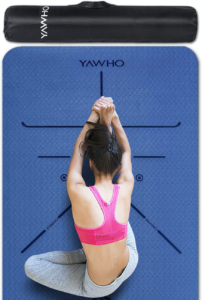
Click here for the lowest price
At 72 inches long, 26 inches wide, and 0.25 inches thick, the YAWHO yoga mat is a bit wider and thinner than the average yoga mat, making it perfect for beginners. It’s made of TPE material which provides a non-slip, skidproof, and odorless mat that boasts impressive elasticity with its anti-tear design.
One thing that makes this yoga mat stand out among the competition is the built-in alignment system, that provides physical lines and focal points on the mat to help with proper alignment during your yoga sessions.
3. Crown Sporting Goods Yoga Cloud Ultra-Thick 1″ Yoga Mat
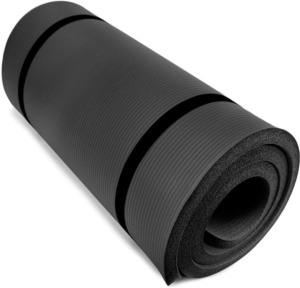
Click here for the lowest price
The Crown Sporting Goods yoga mat is one of the thicker yoga mats on the market at 1-inch, and is highly regarded for the remarkable support and cushioning it provides users. With a thickness that’s approximately four times greater than the average yoga mat, this mat is superior when it comes to supporting wrists, knees, and other joints during all types of yoga poses.
The Crown Sporting Goods yoga mat includes non-slip ridges and incredible floor traction to prevent slips and falls. This mat is also moisture-resistant, simple to clean and easy to pack up with its built-on carrying strap.
4. Incline Fit Ananda 1″ Extra Thick Yoga Mat
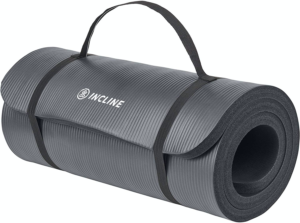
Click here for the lowest price
The incline fit yoga mat is great for yoga enthusiasts with previous injuries and joint pain. With an incredible thickness of 1 inch, this mat provides support to the knees and wrists during some of the more intense weight-bearing yoga poses.
The incline fit yoga mat is also free of latex and heavy metals, making it healthier for both you and the environment.
5. JadeYoga Voyager Yoga Mat
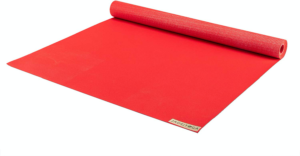
Click here for the lowest price
The JadeYoga Voyager yoga mat is a bit shorter and thinner than most of the other mats on our list, making it perfect for more of a grounded feeling. It’s made of an all-natural rubber material designed to provide consumers with an unbeatable grip.
Thanks to its thin structure, the JadeYoga yoga mat is light and easily transported anywhere.
6. arteesol Yoga Mat
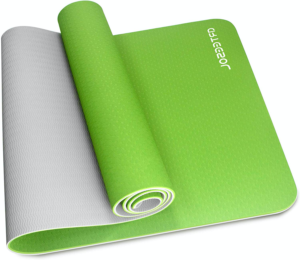
Click here for the lowest price
The arteesol yoga mat is a high-quality TPE yoga mat that provides approximately 30% more cushioning than standard yoga mats. It comes with non-slip texturing on both sides to avoid slips and injury.
The arteesol yoga mat is also highly tear-resistant, free of heavy metals, and completely odorless.
7. LOKATSE HOME All-Purpose Thick Yoga Mat
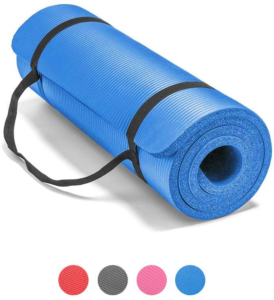
Click here for the lowest price
The LOKATSE HOME yoga mat is an all purpose mat designed to cushion your joints during intense yoga sessions. Due to its anti-skid design, this yoga mat provides excellent grip and stability on even the slipperiest of surfaces.
This mat is also waterproof, preventing bacteria from building up during sweaty sessions.
8. Rolling Sands Yoga Pilates Mat
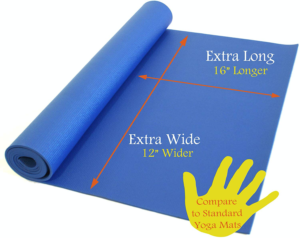
Click here for the lowest price
The Rolling Sands yoga mat is one of the largest and thickest mats on the market coming in at 84 inches long, 36 inches wide, and 0.25 inches thick.
This mat is also extremely durable and provides a non-slip texture to guarantee balance and traction during even sweaty hot yoga sessions.
9. Liforme Original Yoga Mat
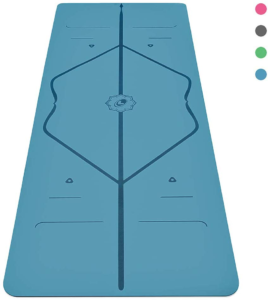
Click here for the lowest price
The Liforme yoga mat is made entirely of all-natural rubber material, providing some of the best grip and balance available on the market.
This yoga mat also includes an AlignForMe design that displays helpful lines and focal points to keep your body in proper alignment during challenging poses.
10. Clever Yoga Yoga Set Kit 7-Piece
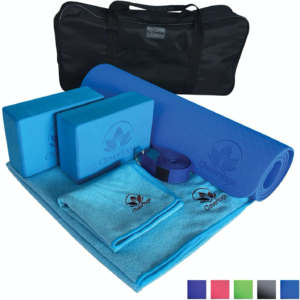
Click here for the lowest price
The Clever Yoga 7-piece kit provides a wide assortment of yoga supplies including a high-quality yoga mat, a towel, two yoga blocks, a yoga strap, a yoga hand towel, and an ergonomic carrying case.
The actual mat is thicker than most other mats at 0.25 inches thick providing a good balance of support and cushioning without taking away from that grounded feeling. It’s also made of non-slip and anti-tear materials so that it can last a lifetime.
How We Ranked
We ranked products like Crown Sporting Goods highly for not only providing grip for the user but also floor traction to prevent slippage. Mat size was not really an issue, and as long as a yoga mat was within a 10% range of the standard length and width, we accepted it.
Regarding mat thickness, there were two schools of thought. Some people like thinner mats so they can get that grounded feeling. Others prefer thick cushioning to protect their joints. In general, we ranked thicker mats, like Incline fit, higher because they offered more safety and reduced major pressure points on the body, allowing people with injuries to safely perform yoga.
To differentiate the good from the best, we looked for products like Yawho that included alignment guides. Alignment guides help users keep proper form while performing yoga without the need of an instructor. This not only allowed for proper technique but helped to prevent unnecessary injuries.
Lastly, we looked at eco-fridnelienes. Our top picks, like Balance GoYoga+, used only eco-friendly material to help promote a greener planet.
Benefits
Using a grounded yoga mat may reduce blood viscosity. Yoga, on its own, provides great benefits to physical, mental, and spiritual health. However, some studies show that the type of yoga mat you use may further improve the benefits you reap.
In a 2015 study, researchers determined that using a thinner yoga mat provides a greater grounding experience while also reducing blood viscosity. Furthermore, participants who used a grounded mat experienced reduced systolic and diastolic blood viscosity post-exercise. Researchers concluded that the reduction in viscosity was a direct result of grounding and its effect on inflammation within the body (1).
Yoga mats help to prevent injuries during yoga. Yoga often requires a strong grip to hold difficult poses in place. Also, since yoga is usually physically challenging, it tends to cause people to slip, making stability difficult. Yoga mats allow for extra grip to prevent slippage and injuries that would occur otherwise. High-quality yoga mats can also help prevent injuries as they cushion your knees and joints.
Yoga mats allow for any floor to become a workout area. Since yoga mats are so portable, lightweight, and versatile, they allow you to take them virtually anywhere, turning a normal floor into a yoga-friendly environment.
Yoga mats help improve balance during your workout. Yoga poses can both be uncomfortable and challenging, making balancing a difficult act. Yoga mats help improve balance by providing a solid foundation for you to practice on. Many yoga mats also come with added grip and cushioning to further enhance balance during the most difficult poses.
Yoga performed on yoga mats may improve mindfulness. In a 2019 study that analyzed weekly yoga participants, scientists discovered that yoga-practicing individuals were more likely to experience self-compassion, mindfulness, and social-connectedness on the days they did yoga (2).
Another 2019 study concluded that participants who participated in a 5-week program consisting of 60-minute mindfulness and yoga exercises experienced a significant increase in mindfulness, compassion, and mental health status. In addition, anxiety, depression, and stress were also reduced in study participants, which shows the incredible effects that yoga has on mental health and mindfulness (3).
Yoga mats can help to reduce pain and tension. With a large range of movements, exercises, and poses, yoga performed on yoga mats is able to effectively target and reduce pain and tension within the body.
In a 2020 study focusing on pediatric pain, children participating in the study did yoga once per week with a trained specialist. After a single session, study participants were more likely to experience reduced mental, physical, and emotional tension within the body and mind. Given these results, more frequent participation in yoga has even greater potential in affecting these areas (4).
In another 2020 study focusing on low-income populations, researchers learned that yoga greatly reduced neck and back pain in individuals (5).
Yoga mats may help with fibromyalgia. A 2019 study researched the effects of yoga on patients with fibromyalgia. This study revealed that consistent participation in a yoga routine has the ability to reduce pain associated with fibromyalgia as well as improving the quality of sleep in participants (6).
While yoga on its own should not be used to treat health conditions, it can significantly improve symptoms occurring as a result of major conditions.
Yoga mats can help reduce stress in high-stress persons. In a unique 2020 study seeking to learn the effects of yoga on women with high-risk pregnancies, researchers surveyed this population after participating in frequent 30-minute yoga sessions. Of the responses they received from study participants, the researchers determined that yoga caused a reduction in stress in those in an already highly stressful situation (7).
Another study performed in 2019 selected a group of parents that all had children diagnosed with cancer. After a 12-week intervention period in which participants did yoga, the general consensus was that yoga greatly reduced stress and improved overall quality of life in participants (8).
Yoga performed on yoga mats can improve physical fitness and health in children. In a 2019 study analyzing the effects that yoga has on children aged 10 to 12, researchers had study participants perform yoga between once and three times a week for a period of 8 weeks. After the trial period was over, participants were tested on their physical fitness abilities. The results showed improvements in most balance and flexibility tests after consistent yoga participation (9).
There have also been studies conducted on children diagnosed with autism. A 2019 study concluded that, in children aged five to 13, an eight week period of yoga greatly improved motor performance and imitation skills (10).
Side Effects
Yoga mats can breed dangerous bacteria. Yoga mats tend to absorb all the sweat dripping off your body during intense yoga sessions, which can breed bacteria if not cleaned regularly.
Yoga mats may contribute to injuries during yoga. Practicing yoga techniques properly is incredibly important to reduce the sudden and long-term development of exercise-related injuries. In a study conducted in 2014, researchers were looking to determine the rate of injury development in those who do yoga and whether or not injury led to discontinued use. Previous studies determined that upwards of 20% of people who do yoga have experienced at least one injury as a result.
In the 2014 study, about 1% of study participants that experienced a yoga-related injury discontinued their yoga practices. A remarkable one-third of those injured actually pursued medical attention as a result of their injury. While these studies show that yoga-related injuries are relatively rare, they are possible, and participants should exude extreme caution (11). Injuries seem to be more frequent if one uses an old, worn, or low-quality yoga mat.
Yoga performed on yoga mats can negatively impact persons with mental health conditions. In a 2014 study, researchers focused on the concept of the benefits and risks of yoga for individuals with bipolar disorder. Though a striking majority of participants enjoyed yoga and experienced positive benefits, there is a risk of heat intolerance as a result of taking antipsychotic medication and self-criticism and anxiety that comes with doing yoga in the group setting (12).
In a 2016 study focusing on the effects of yoga in younger populations with anxiety and depression, there were a few risks associated with participation in yoga sessions. In particular, there was an increased risk of rapid breathing, worsening of symptoms of depression and mania, and increased self-consciousness when in the group setting (13).
Yoga performed on yoga mats may be dangerous for persons with certain physical health issues. Persons with neck or spine issues should be careful when performing yoga, especially when using an especially thin yoga mat. Furthermore, persons suffering from osteoporosis should be careful when performing certain poses as they may lead to injury.
Recommended Dosage
Whether you’re a yoga enthusiast or a beginner, using a proper yoga mat can make a dramatic difference in yoga performance. Generally speaking, the ideal yoga mat has a non-slip design and a level of thickness that provides support and reduces pressure point activation while doing all yoga poses. You can use a yoga mat as often as you like, as their is no recommended dosage.
FAQ
What is the best thickness for a yoga mat? The best thickness for a yoga mat depends on your personal needs and your previous yoga experience. There are mats explicitly designed for grounding, while others are more ideal for cushioning and support.
When should you use a thinner yoga mat? If you feel confident in your balance and stability as it is, you might prefer a thinner yoga mat. This type of mat will guarantee your grip when performing your poses while also allowing you to feel more connected to the ground throughout your session. A thin yoga mat (less than 0.25 inches thick) will give you a more natural feeling during your sessions.
When should you use a thicker yoga mat? If you currently have muscle, bone, or joint injuries, but you’re still interested in doing yoga, there are mats ideal for those with your conditions. With a thicker mat, you can prevent excess pressure on your body’s pressure points and reduce stress on your knees, wrists, spine, hips, and other major body parts. Anything over 0.5 inches would be considered thick, with the thickness being directly correlated to the comfort provided by the mat.
What is the purpose of a yoga mat? The average yoga mat is used with the intention of providing stability and balance throughout yoga sessions. Any high-quality yoga mat is designed in a way that provides a slip-resistant feature on both sides of the mat.
With slip-resistant design on the top of the mat (the side you’ll be using), you can guarantee that your hands, feet, and other body parts will remain stable and balanced during all yoga poses. This is ideal for injury prevention, gaining the most physical benefit from each exercise, and learning the poses without undue stress.
Slip-resistance features on the opposite side (the side that’ll be in contact with the floor) will prevent the mat from slipping upon moving. This feature gives you a stable surface to practice your poses while also limiting the risk of injury.
Depending on the thickness of the mat, a yoga mat can also provide you with cushioning and support during more intense exercises. If you have injuries or are just trying to prevent the development of injuries, using a thicker yoga mat can reduce pressure point activation and limit the direct stress placed on your joints and bones.
Are yoga mats really necessary? While you can technically do yoga anywhere, yoga mats are great for providing stability and support during your exercises.
If you’re doing yoga on the carpet, tile, or hardwood flooring, you’re going to experience a sliding effect during your poses. Though you might not begin slipping immediately, you might once your palms and soles become sweaty and make balance more difficult.
In terms of injury prevention, yoga mats are absolutely necessary. Yoga mats offer traction and grip to allow you to maintain your balance during a variety of exercises. By not securing this grip, you’re putting yourself at risk for falling, slipping, and developing injuries.
If you’re looking for more of a natural yoga session, one of the best options would be to get an extremely thin yoga mat. This will help to guarantee a natural, grounded feeling while also providing grip and stability to avoid injuries.
What causes slipping on a yoga mat? There are several reasons you may be slipping on your yoga mat, but there are ways to prevent a slippery mat and produce a more delightful yoga session.
The most common reason you’re slipping on your yoga mat is that your palms and feet have become sweaty. The best thing you can do to counteract this issue is to purchase a mat designed to provide traction 100% of the time or invest in a yoga towel to wipe your hands and feet between major poses during your session.
How do I wash my yoga mat? Because most yoga mats are water-resistant and washable, the best way to wash your yoga mat is with a mixture of soap and water. By simply wiping the surface of your mat with soap and water, you’re removing bacteria and sweat from the mat while also reducing the build-up of unfavorable odors.
Why is it essential to wash a yoga mat regularly? It’s incredibly important to practice good hygiene and cleaning habits when it comes to owning a yoga mat. Failure to clean your mat frequently will result in odors, bacteria, fungus, and even mold. Do your best to clean your mat as often as possible, preferably after each yoga session.
After washing your yoga mat, you should hang it up to air dry. If you don’t live in a humid environment, your mat will be dry and ready to go the next day for your next yoga session.
Do yoga mats work on carpet? Generally speaking, yoga mats perform pretty well on carpets. However, there are a few things you need to take into consideration. The first thing you need to do is to make sure you have a yoga mat that has a grip on both sides. While it’s important to have a grip on your side to keep balance during your poses, carpet is more conducive to sliding objects. By having a grip on both sides, you’re ensuring that your yoga mat won’t slide during exercises and movements.
The type of carpet you have will also play a role in whether or not your yoga mat will perform well. Flatter and thinner carpet are the ideal type of carpet for yoga mats. By using a yoga mat on a thicker carpet, you’re more likely to sink into the carpet, which will cause an unnatural balance during exercises.
How do I keep my yoga mat from sliding on the carpet? Your best bet to prevent your yoga mat from sliding on the carpet is to invest in a yoga mat with superior levels of grip and traction. For the most part, the best option would be a yoga mat made of some type of rubber material. With a rubber yoga mat, the mat will be much more stable on the carpet, and you’ll slide much less than you currently are.
Another suggestion would be to do your yoga in another room with a thinner carpet. A thinner carpet is more comparable to harder flooring and is less likely to cause your yoga mat to slip during exercise.
How do you break in a yoga mat? When you first buy a yoga mat, it’ll probably be relatively stiff and a bit uncomfortable to use. The best thing you can do to break in your yoga mat is to use it frequently.
Some people also suggest leaving your yoga mat out in the sun, washing it with a sea salt scrub, or cleaning it, to speed up the “breaking in” process.
How does yoga performed on yoga mats benefit you physically and mentally? In terms of physical health, you’re more likely to experience an improvement in flexibility, muscular strength, reduced heart rate, and better balance. When it comes to mental health, the effects may be a sense of mindfulness, calmness, reduces stress, lower levels of anxiety, and boosted mood.
How long do yoga mats last? The length of time your yoga mat will last depends on how consistently you use it, how you use it, and what the mat is made from. If you’re using your mat every single day doing intense exercise, your yoga mat may only last less than a year. However, if you are using it only a few times per week, it should last closer to 2 years.
Which type of yoga mat lasts the longest? In particular, a rubber yoga mat has the potential to last the longest. These mats are usually tougher to break and tear and are more durable in the long-term.
What should you wear on your feet to minimize damage to your yoga mat? While it’s possible to do yoga wearing shoes or socks, the best choice is to do yoga barefoot. The primary reason behind this is the amount of balance provided by being barefoot while also limiting damage to your yoga mat. By being barefoot, you also have a greater range of motion and don’t have to worry about your shoes digging into your ankles or ruining your mat when you’re doing more challenging poses.
What is the best yoga mat thickness? The best yoga mat thickness really depends on the individual. The most popular mats tend to be about 1/4 inch thick. Persons with joint issues or who want extra cushioning should consider thicker mats. People looking for a more grounded feeling should purchase a mat with a thickness level of about 1/8 inch.
What yoga mat size is the best? The standard size of a yoga mat is usually 24″ x 68″. Taller people should look for longer mats, probably closer to 80″. Persons with sensitive knees will also benefit from a longer mat since they can roll up the ends to add extra cushioning. Men and women with broad backs may need a mat wider than 24″.
What is the price of a standard yoga mat? Yoga mats can range from $10 to over $100 depending on size and quality. Cheaper mats tend to break quicker since they are made with cheap material. Higher quality mats tend to be more comfortable and come with extra features like knee padding, waterproof design, and a carrying case.
What should a beginner look for when picking a yoga mat? Beginners should look for a mat that is of normal thickness. A very thick mat, while comfortable, often provides an unstable surface, which can be dangerous for some users. Beginners should also look at a yoga mat as an investment rather than a purchase and opt for a more expensive option.
Should men choose a different yoga mat than women? Since men tend to be taller and more muscular, it might be in their best interest to select a different yoga mat. Specifically, they will probably want a wider, longer, and thicker yoga mat that has extra grip and comes with moisture-wicking technology since they tend to sweat more.
Do you need a yoga mat to perform yoga? Technically, you do not need a yoga mat to perform yoga, but most studies require it. Yoga mats help to keep germs away and help to avoid a big puddle of sweat. Yoga mats also help to improve grip, posture, and reduce strain, making them that much more useful.
What is the best way to clean a yoga mat? Most yoga mats can be cleaned with soap and warm water. If your yoga mat is exceptionally dirty from being outside, you can use some diluted detergent. If your yoga mat has a microfiber surface, you can throw it into a washing machine to clean it. Yoga mats should never be put in a dryer – instead, allow them to hang dry.
Why do some yoga products come with straps? Yoga mats with straps are convenient for carrying around and rolling up the mat into a compact log.
What type of yoga mat is the best for hot yoga? A lot of sweat is expelled during hot yoga, which alters the type of yoga mat you need. In general, you’ll want to look for a mat with extra grip and micro fiber surface to soak up the sweat. You’ll also want to make sure your mat is machine washable since it will need to be cleaned regularly.
Are yoga mats and yoga rugs the same thing? No, yoga rugs are often made of cotton, whereas yoga mats tend to be made of synthetic materials like rubber. Yoga rugs tend to provide less support and grip than a yoga mat since they are thinner and are not built with grip technology.
Do yoga mats breed bacteria? Unfortunately, if a yoga mat is cleaned regulary, it can breed bacteria from all the sweat it absorbs.
Can yoga mats cause injury? In general, yoga mats help to prevent injury. However, if yoga mats are not taken care of or misused, they can lead to injusry. Furthermore, yoga mats that are too thick can cause balance issues that can lead to falls and injuries.
Are yoga mats made from latex? No, many high-quality yoga mats are not made from latex. Instead, most are made from a range of synthetic rubber formulations.
Are closed-cell yoga mats better than open-cell yoga mats? Closed-cell yoga mats tend to more hygienic than open-cell yoga mats because they can resist sweat better. This allows for no sweat or dirt to soak in and cause bacteria to breed (14). However, closed cell mats tend to be slipperier and offer less grip, especially under sweaty conditions like hot yoga.
Is UV light bad for yoga mats? Unfortunately, UV light can damage rubber yoga mats.
Related Articles
Recap
Yoga mats are necessary in order to provide reliable stability and balance during your yoga sessions. Furthermore, they’re proven to be extremely helpful for those with muscular, joint, bone, and nerve injuries.
Whether you’re looking for more room to move during your yoga sessions, more cushioning for the purpose of comfort, or a thinner mat for a grounded feeling, there are plenty of options available for purchase.
One of the most important things you can do is practice yoga consistently and become accustomed to using your particular mat. This will provide you with the most positive experience and allow you to gain more from your sessions.
For FitBug’s #1 Yoga Mat recommendation, click here.